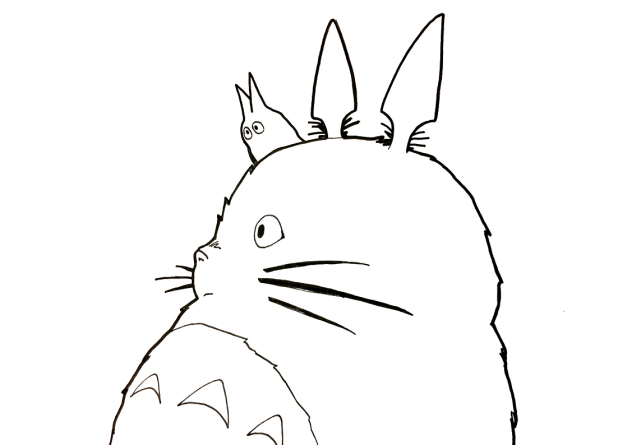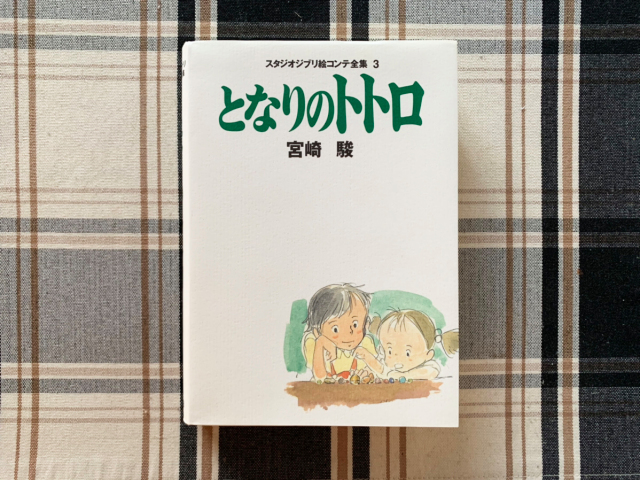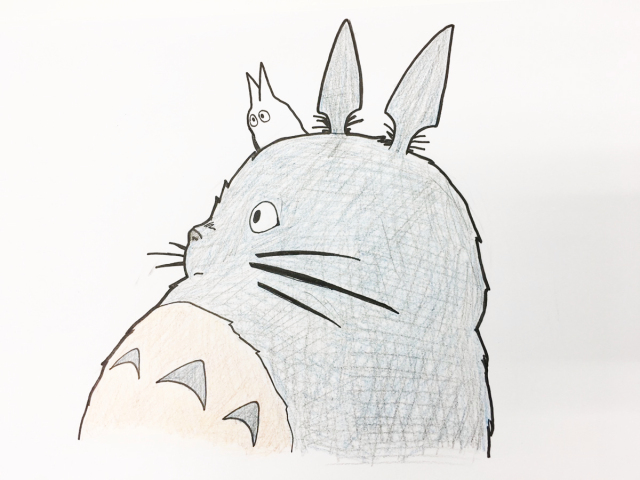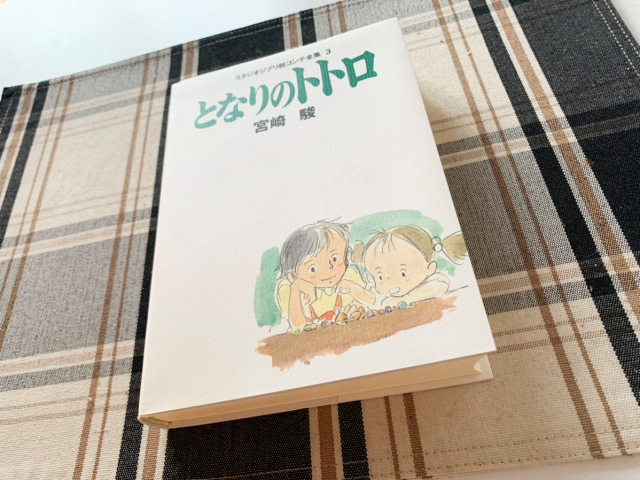
Totoro’s missing dialogue, Kanta’s final revelation, and… Totoro has a crush on Satsuki?!
It’s been over three decades since Studio Ghibli’s My Neighbour Totoro debuted in Japan in 1988, and we’re still uncovering little-known secrets behind the beloved animated feature film.
This week we discovered another set of My Neighbour Totoro secrets, after a recent broadcast of the movie on Japanese television prompted us to take a look at the original storyboards for the film, found in the 2010 book My Neighbor Totoro (Studio Ghibli Storyboard Collection, Volume 3).
The book, by Ghibli director and co-founder Hayao Miyazaki, contains a number of storyboard notes written in his hand during production, which add some juicy details to the narrative and an extra layer of depth to the well-known story.
Some of Miyazaki’s direction didn’t make it into the movie, and after reading through the book, we’re now seeing some of the scenes in a different light. So let’s take a look at some of the secrets behind the film, starting with the relationship between Satsuki — Mei’s older sister and female lead — and Kanta, the boy who develops a crush on her.
What does Kanta say to Satsuki at the very end of the movie?
The first meeting between these two characters is a memorable moment in the story, but not because Kanta makes a good impression on his crush. He stops by Satsuki’s new house to pass something on from his mother to his grandmother, who’s helping Satsuki and her family get settled in, and after initially being stumped for words, he quickly races outside and yells at her, “You live in a haunted house!”
However, as the story progresses, Sattsuki and Kanta go from poking their tongues out at each other to showing a heartwarming level of care for one another, expressed at the very end when she refers to him affectionately as “Kan-chan” instead of the less-friendly “Kanta”.
“What’s that? I never heard her say “Kan-chan”, you might be saying to yourself, even if you’ve watched the original non-dubbed version of the film. That’s because she says it right at the very end, when the final scenes of the movie are shown as the “My Neighbour Totoro” ending song plays over the top of their dialogue. At this moment, you can see the character’s mouths move but you can’t hear what they’re saying.
However, the storyboard for this scene reveals what they’re saying to each other at this moment:
Satsuki: “Thank you Kan-chan”
Kanta: “Hehe … I got a flat tyre so I couldn’t make it to the hospital.”
[Quoted from My Neighbor Totoro (Studio Ghibli Storyboard Collection, Volume 3)]
It’s a short exchange but it explains quite a bit, as Kanta previously told Satsuki she should go home as he would go to the hospital to look for her missing sister Mei. However, Satsuki ends up finding Mei and they travel on the Catbus to the hospital together, but Kanta is nowhere to be seen.
So was Kanta playing a prank on Satsuki? Was he distracted by something on the way that made him forget about the mission to find Mei? No – the revelation that he was sidelined by a flat tyre means he really was trying to get to the hospital for Satsuki. And if you look closely at that scene at the end, you’ll be able to see his busted front tyre.
Totoro’s Missing Dialogue
The next big revelation from the storyboards is the fact that the giant Totoro initially had dialogue. In the scene where Mei encounters Totoro sleeping in the forest, Miyazaki had envisaged this conversation between the two characters:
Mei: “Who are you? Are you a big dust bunny?”
Totoro: “I’m sleepy”
Mei: “Gwaaaaaaa!” (imitating Totoro’s large yawn)
Totoro: “Are you sleepy too?”
Mei: “Totoro!!! You’re Totoro, aren’t you?”
Totoro: “I don’t know”
Mei: “I bet you’re Totoro”
[Quoted from My Neighbor Totoro (Studio Ghibli Storyboard Collection, Volume 3)]
This puts a different spin on their first meeting in the film, where Totoro appears to communicate its name to Mei by roaring out three syllables that sound like “To-to-ro”. According to Miyazaki’s initial vision, however, Totoro didn’t know what its name was — it probably didn’t even know the concept of names existed — and Mei was the one who gave the giant character its name.
At the Bus Stop In the Rain
During the scene at the bus stop in the rain, where Totoro appears next to Satsuki as she carries her sleeping sister on her back, Totoro simply stands there as drops of rain drip onto its snout from the leaf on its head. When Satsuki asks, “Are you Totoro?” the giant character simply looks at her from the side of its eye and says nothing.
In the original storyboard, however, this is the exchange that occurs between the two at that moment:
Satsuki: “Totoro?”
Totoro: “What’s that? What’s Totoro…”
[Quoted from My Neighbor Totoro (Studio Ghibli Storyboard Collection, Volume 3)]
This original storyboard version also shows Totoro being fascinated by the drops of rain that drip onto his nose from the leaf, and its confusion over the word “Totoro” reinforces the notion that the mysterious giant doesn’t know Totoro is its name — it doesn’t even know what Totoro is or what it’s meant to mean.
And if you were confused as to why Totoro jumps under the umbrella, the storyboard images suggest the initial wide grin after the raindrops hit the umbrella is because Totoro thinks it’s a great musical instrument. The jump is meant to convey Totoro’s excitement over the sound being made.
トトロやってるー🙌
— 🍒ガースー🐻 (@0802Gasu) August 14, 2020
私が高校1年生の時に部活の女子の先輩が急な雨で部室前で雨宿りしてたから傘さしながらジャンプして隣まで行って「トトロが迎えきました。傘どうぞ」って渡したのは良い思い出🤧 pic.twitter.com/IyNNs49ytx
Totoro is The Wind?
Another change in direction that deserves a mention is the scene when Mei, Satsuki and the three Totoros fly through the air and swoosh past the long grass on a magic spinning top. In the film, Satsuki says “We’re the wind!” but written on the storyboard is: “Yes — the voice of Totoro is the wind!!”
If you listen to the audio during this scene, the sound of the wind as they swish by really does sound a lot like Totoro’s roar, only on a much quieter level.
Totoro has a crush on Satsuki?
Finally, we have a bombshell of a theory, related to the climactic sequence towards the end when Satsuki asks Totoro for help in finding her missing sister.
At this part of the movie, Satsuki tumbles onto the sleeping Totoro’s chest, just like her younger sister did earlier, and when Totoro wakes and sees her crying he takes her into his arm. He then sits up and blushes while holding her, letting out a loud roar before they take off into the sky together.
In the film, he doesn’t say anything intelligible but according to the storyboard, Totoro says:
Totoro: “Kawaii”
[Quoted from My Neighbor Totoro (Studio Ghibli Storyboard Collection, Volume 3)]
“Kawaii” — like its English translation, “cute” — can be used when gushing over adorable children and animals and also when gushing over your crush. However, the fact that Totoro’s cheeks turn red suggest the character is actually blushing over a crush, and if that’s true, then My Neighbour Totoro can be seen as a romantic comedy with Totoro and Kanta as love rivals in a very bizarre love triangle.
昨日 録画しておいた隣のトトロを見て、何故かボロ泣き(^^;
— Guro (@Guro_ceroZ) August 15, 2020
声優さんの演技が上手すぎるンゴ
メイが七国山病院に行く途中で迷子になって、サツキがトトロに『今頃、あの子道に迷って泣いてるわ。どうして良いのか分からないの…』でダメだった pic.twitter.com/HRfV1VLvvI
Regardless of whether Totoro really does have a crush on Satsuki or not, the two do share a very special bond, and similar big-sibling roles too, as Totoro acts as a big brother to the smaller forest Totoros much in the same way Satsuki is a big sister to Mei.
So there you have it — some of the little-known secrets behind the making of My Neighbour Totoro, thanks to handwritten notes and storyboards from the director of the movie. The book provides some fascinating insights into a film we thought we knew so well, and opens up options for reinterpreting some of the movie’s most memorable scenes.
It also makes a great companion for another Studio Ghibli tome, The Place Where Totoro Was Born, which takes us into the movie’s real-world setting of Sayama Hills, also known as Totoro’s Forest, which is the real birthplace of Totoro.
Images: ©SoraNews24
● Want to hear about SoraNews24’s latest articles as soon as they’re published? Follow us on Facebook and Twitter!
[ Read in Japanese ]




 Studio Ghibli reveals surprising secrets hidden in My Neighbour Totoro
Studio Ghibli reveals surprising secrets hidden in My Neighbour Totoro Official My Neighbor Totoro cookbook teaches you to make Satsuki’s bento and other Ghibli meshi
Official My Neighbor Totoro cookbook teaches you to make Satsuki’s bento and other Ghibli meshi The secret behind this mysterious Studio Ghibli x Pixar image
The secret behind this mysterious Studio Ghibli x Pixar image Chinese poster for Totoro’s first theatrical release in country has a beautifully subtle secret
Chinese poster for Totoro’s first theatrical release in country has a beautifully subtle secret How to play Totoro’s mysterious flute from My Neighbour Totoro【Pics & Video】
How to play Totoro’s mysterious flute from My Neighbour Totoro【Pics & Video】 Visiting Japan’s Gyarados Pokémon park in the city with a special connection to Magikarp【Photos】
Visiting Japan’s Gyarados Pokémon park in the city with a special connection to Magikarp【Photos】 Bear meat noodles?!? Tokyo restaurant adds a new kind of niku soba to its menu【Taste test】
Bear meat noodles?!? Tokyo restaurant adds a new kind of niku soba to its menu【Taste test】 Pikachu’s chunky original design is back as a plus-sized plushie【Photos】
Pikachu’s chunky original design is back as a plus-sized plushie【Photos】 Majority of Japanese women in survey regret marrying their husband, but that’s only half the story
Majority of Japanese women in survey regret marrying their husband, but that’s only half the story Massive manga collaboration bringing 100 years of Shueisha manga to Uniqlo T-shirts【Photos】
Massive manga collaboration bringing 100 years of Shueisha manga to Uniqlo T-shirts【Photos】 Starbucks Japan releases new drinkware and goods for Valentine’s Day
Starbucks Japan releases new drinkware and goods for Valentine’s Day Japan super budget dining – What’s the best way to spend 1,000 yen at McDonald’s?
Japan super budget dining – What’s the best way to spend 1,000 yen at McDonald’s? Cloth randoseru Japanese backpacks are here to lighten load on parents’ wallets and kids’ backs
Cloth randoseru Japanese backpacks are here to lighten load on parents’ wallets and kids’ backs Taste-testing Japan’s three biggest convenience stores store-brand cup ramen【Taste test】
Taste-testing Japan’s three biggest convenience stores store-brand cup ramen【Taste test】 We followed Tokyo’s mystery walking map and ended up creating our own bar-hopping adventure
We followed Tokyo’s mystery walking map and ended up creating our own bar-hopping adventure Starbucks Japan releases new Frappuccino and latte for Valentine’s Day
Starbucks Japan releases new Frappuccino and latte for Valentine’s Day Totoro cream puffs and Catbus cookies are finally available in downtown Tokyo
Totoro cream puffs and Catbus cookies are finally available in downtown Tokyo Japan’s kid-friendly ski program is now selling Pikachu snowboards for a limited time only
Japan’s kid-friendly ski program is now selling Pikachu snowboards for a limited time only Japanese women showing rebounding interest in giving Valentine’s Day chocolate【Survey】
Japanese women showing rebounding interest in giving Valentine’s Day chocolate【Survey】 McDonald’s Japan releases a Mushroom Mountain and Bamboo Shoot Village McFlurry
McDonald’s Japan releases a Mushroom Mountain and Bamboo Shoot Village McFlurry Ramen restaurant’s English menu prices are nearly double its Japanese ones, denies discriminating
Ramen restaurant’s English menu prices are nearly double its Japanese ones, denies discriminating 10 times to avoid traveling in Japan in 2026
10 times to avoid traveling in Japan in 2026 Starbucks Japan ready to get Year of the Horse started with adorable drinkware and plushies【Pics】
Starbucks Japan ready to get Year of the Horse started with adorable drinkware and plushies【Pics】 Our 52-year-old pole dancing reporter shares his tips for achieving your New Year’s exercise goal
Our 52-year-old pole dancing reporter shares his tips for achieving your New Year’s exercise goal 7-Eleven Japan starts new temporary luggage storage service in over 300 branches
7-Eleven Japan starts new temporary luggage storage service in over 300 branches Disillusionment at Tsukiji’s tourist-target prices led us to a great ramen restaurant in Tokyo
Disillusionment at Tsukiji’s tourist-target prices led us to a great ramen restaurant in Tokyo Japan may add Japanese language proficiency, lifestyle classes to permanent foreign resident requirements
Japan may add Japanese language proficiency, lifestyle classes to permanent foreign resident requirements Lacquerware supplier to emperor of Japan and Pokémon team up for new tableware
Lacquerware supplier to emperor of Japan and Pokémon team up for new tableware Survey asks foreign tourists what bothered them in Japan, more than half gave same answer
Survey asks foreign tourists what bothered them in Japan, more than half gave same answer Japan’s human washing machines will go on sale to general public, demos to be held in Tokyo
Japan’s human washing machines will go on sale to general public, demos to be held in Tokyo We deeply regret going into this tunnel on our walk in the mountains of Japan
We deeply regret going into this tunnel on our walk in the mountains of Japan Studio Ghibli releases Kodama forest spirits from Princess Mononoke to light up your home
Studio Ghibli releases Kodama forest spirits from Princess Mononoke to light up your home Major Japanese hotel chain says reservations via overseas booking sites may not be valid
Major Japanese hotel chain says reservations via overseas booking sites may not be valid Put sesame oil in your coffee? Japanese maker says it’s the best way to start your day【Taste test】
Put sesame oil in your coffee? Japanese maker says it’s the best way to start your day【Taste test】 No more using real katana for tourism activities, Japan’s National Police Agency says
No more using real katana for tourism activities, Japan’s National Police Agency says Starbucks Japan reveals new sakura drinkware collection, inspired by evening cherry blossoms
Starbucks Japan reveals new sakura drinkware collection, inspired by evening cherry blossoms Updated cherry blossom forecast shows extra-long sakura season for Japan this year
Updated cherry blossom forecast shows extra-long sakura season for Japan this year Studio Ghibli releases amazing new My Neighbour Totoro merchandise in Japan
Studio Ghibli releases amazing new My Neighbour Totoro merchandise in Japan Studio Ghibli unveils My Neighbour Totoro miniature house model
Studio Ghibli unveils My Neighbour Totoro miniature house model How to get a job in anime with Studio Ghibli director Hayao Miyazaki
How to get a job in anime with Studio Ghibli director Hayao Miyazaki My Neighbor Totoro, Castle in the Sky kitchens to be recreated in life-size at Ghibli Museum
My Neighbor Totoro, Castle in the Sky kitchens to be recreated in life-size at Ghibli Museum The Place Where Totoro Was Born: New Studio Ghibli book includes art by Hayao Miyazaki’s wife
The Place Where Totoro Was Born: New Studio Ghibli book includes art by Hayao Miyazaki’s wife Snuggle up to Totoro with cosy new three-piece Ghibli bag collection
Snuggle up to Totoro with cosy new three-piece Ghibli bag collection Cosplayers pull off touching recreation of sisters Mei and Satsuki from My Neighbor Totoro【Pics】
Cosplayers pull off touching recreation of sisters Mei and Satsuki from My Neighbor Totoro【Pics】 Watch “My Neighbor Totoro” short sequel “Mei and the Kittenbus” at Studio Ghibli’s theatre
Watch “My Neighbor Totoro” short sequel “Mei and the Kittenbus” at Studio Ghibli’s theatre Official Studio Ghibli x Pixar image causes a buzz online
Official Studio Ghibli x Pixar image causes a buzz online Someone secretly left a beautiful, touching present for Totoro at Tokyo’s Ghibli Museum【Photos】
Someone secretly left a beautiful, touching present for Totoro at Tokyo’s Ghibli Museum【Photos】 Celebrate May with a visit to Mei and Satsuki’s house from Ghibli’s My Neighbor Totoro
Celebrate May with a visit to Mei and Satsuki’s house from Ghibli’s My Neighbor Totoro Sleep on Totoro’s belly with Studio Ghibli’s My Neighbour Totoro Nap Cushion
Sleep on Totoro’s belly with Studio Ghibli’s My Neighbour Totoro Nap Cushion Mysterious light-up rainy night-sound Totoro figure doesn’t actually show a scene from the anime
Mysterious light-up rainy night-sound Totoro figure doesn’t actually show a scene from the anime Totoro has a sequel? Thousands of Japanese Twitter users shocked to learn of Ghibli follow-up
Totoro has a sequel? Thousands of Japanese Twitter users shocked to learn of Ghibli follow-up Studio Ghibli releases new My Neighbour Totoro corn gift for Mother’s Day
Studio Ghibli releases new My Neighbour Totoro corn gift for Mother’s Day
Leave a Reply